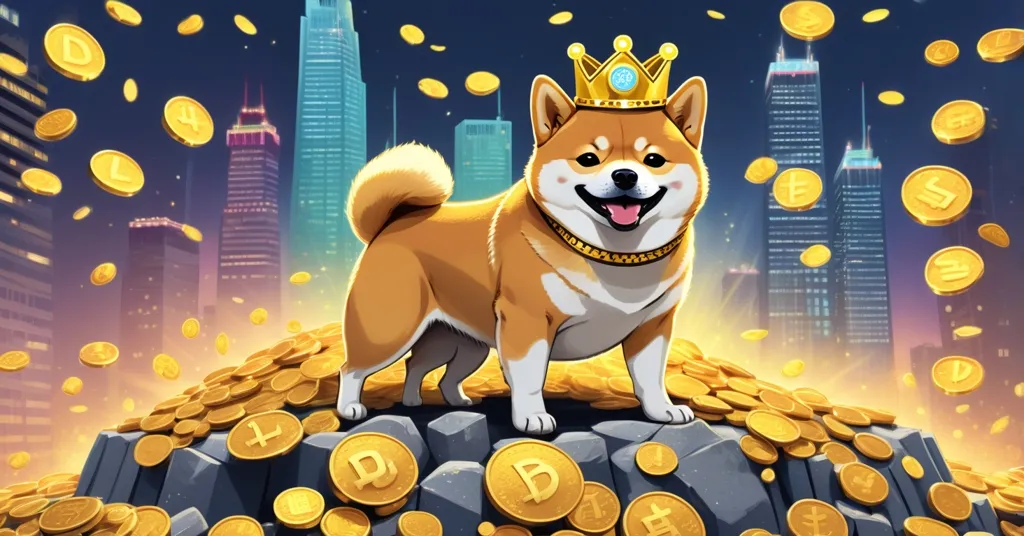Dogecoin Surges Despite DOGE Department Shutdown: Hype Trumps Reality

Dogecoin’s Unstoppable Hype: Price Climbs Despite Trump’s DOGE Department Shutdown
Dogecoin (DOGE) is once again defying all logic, posting gains even as the U.S. Department of Government Efficiency—branded with the same DOGE acronym and tied to Elon Musk’s influence—gets the axe. This government initiative’s collapse should have rattled sentiment, but instead, the meme coin’s price ticked up 1.1% in the last 24 hours while trading volumes surged 20%, proving that in the unhinged world of crypto, community hype often outweighs cold, hard reality.
- Agency Axed: The Department of Government Efficiency (DOGE) is officially shut down, as confirmed by the Office of Personnel Management.
- Dogecoin Gains: DOGE price rises 1.1% with a 20% jump in trading volume, ignoring the bearish news.
- New Contender: Maxi Doge ($MAXI) presale raises over $4 million, targeting traders with high-risk strategies.
The DOGE Department Debacle: A Short-Lived Symbol
Let’s start with the bizarre backstory. The Department of Government Efficiency, acronymed DOGE, was a quirky U.S. government initiative pitched as a way to streamline bureaucratic waste. Spearheaded by Elon Musk under President Donald Trump’s administration, it became an unexpected symbol for Dogecoin enthusiasts. Musk, a long-time DOGE hype man whose tweets have historically sent the meme coin soaring, was tapped to lead this effort, giving the project a surreal crypto connection. When it was first announced, the mere branding association fueled a Dogecoin price spike as retail investors jumped on the narrative. Symbols matter in meme coin territory, even if the department’s actual impact on crypto was negligible.
Fast forward to now, and the dream is dead. Reports of a rift between Trump and Musk have surfaced, though specifics remain murky. The Office of Personnel Management, via its chief Scott Kupor in a statement to Reuters, confirmed the shutdown. Logically, this should have dented Dogecoin’s momentum—after all, losing a high-profile tie-in, however symbolic, isn’t exactly bullish. Yet, the market’s response has been a collective shrug, raising the question: what’s driving this unexpected surge? For those curious about the deeper dynamics behind Dogecoin’s price surge despite the DOGE department collapse, the answer lies in sentiment, not fundamentals. For those new to crypto, this is a classic example of how sentiment, not fundamentals, often rules the roost in meme coin markets.
Dogecoin Price Analysis: Defying Bearish News in 2024
Looking at the numbers, Dogecoin’s resilience is striking. Over the past 24 hours, the token climbed 1.1%, a small but notable gain amid negative headlines. More impressively, trading volume—the total amount of DOGE bought and sold in a given period—spiked by 20%. This suggests active buying interest rather than a panicked sell-off, a sign of strong market momentum. For newcomers, high trading volume often means more eyes (and wallets) are on a coin, fueling potential price swings.
On the price charts, DOGE recently dipped from $0.15 to $0.13 but has held firm at that lower level. This $0.13 mark is what traders call a support level—a price where enough buyers typically step in to stop further drops. It’s not just a random number; back on April 7, when Dogecoin last tested $0.13, it doubled to $0.26 within a month. While past performance isn’t a crystal ball, traders are buzzing about a possible retest of the $0.29 swing high. Some even speculate a rally to $0.47, which would mean a jaw-dropping 224% gain from current levels. A more grounded expectation, based on historical patterns, could still see a 100% jump from $0.13 if momentum holds. But let’s be clear—meme coin price movements are a gamble, not a science, and anyone throwing out guaranteed predictions is likely full of it.
Historically, Dogecoin has seen wild rides driven by pure hype. Remember 2021, when Musk’s tweets and a Reddit-fueled frenzy pushed DOGE to an all-time high of $0.73? That same year, it also crashed hard when the buzz faded. This volatility is the name of the game, and the current rally, while intriguing, is no promise of sustained gains. For those wondering why Dogecoin is rising despite bad news, the answer lies in retail enthusiasm and fear of missing out (FOMO), not in any tangible utility or government endorsement.
Maxi Doge: A Risky Newcomer in the Meme Coin Arena
While Dogecoin rides its chaotic wave, another meme coin is elbowing for attention with a different playbook. Enter Maxi Doge ($MAXI), a presale project that’s already pulled in over $4 million from eager investors. Unlike DOGE, which thrives on cultural memes and Musk’s erratic endorsements, $MAXI is pitching itself as a trader-first community. It offers features like leaderboard contests named “Maxi Gains” and “Maxi Ripped,” alongside real-time sharing of trading tips—or “alpha,” as insiders call it—meant to give members an edge in the market.
What’s got eyebrows raised is their strategy to allocate up to 25% of presale funds to high-leverage trades. For the uninitiated, high-leverage trading means borrowing money to amplify bets on price movements—think of it as playing with fire. A successful trade can yield massive returns, but if the market turns, losses can wipe out investments in a heartbeat. $MAXI plans to funnel any profits into aggressive marketing to boost hype, a move that’s bold but reeks of risk. Meme coin history is littered with presales promising the moon only to vanish with investors’ funds—while $MAXI’s approach is intriguing, it’s a glaring red flag for anyone who’s seen similar schemes implode. Proceed with caution; this could be a game-changer or just another pump-and-dump waiting to happen.
Meme Coins in the Crypto Ecosystem: Chaos with a Purpose?
Zooming out, the Dogecoin saga and $MAXI’s emergence highlight the absurdity and allure of meme coins in 2024. These tokens aren’t built on robust tech like Bitcoin, the gold standard of crypto’s store-of-value proposition, or Ethereum, with its smart contract empire. Instead, they’re powered by internet culture, viral trends, and community fervor—think of them as the viral TikTok dances of finance, fleeting but impossible to ignore while they’re hot. Dogecoin’s ability to rally despite the DOGE department’s collapse isn’t a glitch; it’s a feature of a market where narratives trump logic.
As someone who leans toward Bitcoin maximalism, I’ll admit meme coins grate on my nerves with their lack of substance. Bitcoin is about sovereignty, privacy, and disrupting centralized power—core values of decentralization. Meme coins, by contrast, often feel like distractions, speculative bubbles that risk tainting crypto’s reputation when they inevitably crash or get exposed as scams. Yet, there’s no denying they serve a niche. They’re often the first crypto newbies encounter, a low-barrier entry point that can spark curiosity about blockchain’s broader potential. And in their own chaotic way, they embody crypto’s anti-establishment spirit, thumbing their nose at traditional finance with every shiba inu-themed pump.
Still, the counterpoint looms large. Do meme coins’ onboarding benefits justify the volatility and frequent rug pulls that burn retail investors? Are they a gateway to decentralization or a sideshow that diverts attention from blockchain’s serious use cases? And with regulators already circling crypto, high-profile meme coin pumps—especially tied to political drama like the DOGE department—could invite tougher scrutiny, potentially stifling innovation across the board. It’s worth noting that meme coins reportedly accounted for a significant chunk of trading volume in recent years, with data from platforms like CoinGecko showing their outsized influence during bull runs. This clout comes with baggage, and striking a balance between hype and responsibility is a tightrope walk.
Key Takeaways and Burning Questions on Meme Coin Madness
- Why is Dogecoin climbing despite the DOGE department’s shutdown?
Market sentiment and retail hype are overpowering the negative news, with a 1.1% price rise and 20% trading volume spike showing investors aren’t deterred. - What are realistic price targets for Dogecoin in the near term?
A push to $0.29 seems feasible as a short-term high, while $0.47—a 224% gain—is a long shot; a 100% jump from $0.13 aligns with past patterns but isn’t guaranteed. - What’s the story with Maxi Doge ($MAXI), and is it worth a look?
With over $4 million raised in presale and a focus on traders through contests and tips, $MAXI is interesting but risky—its high-leverage bets could backfire spectacularly. - Do meme coins like DOGE have a serious place in crypto?
They act as cultural phenomena and entry points for new users, but their lack of fundamentals makes them more of a gamble than a long-term investment. - How does community hype outweigh fundamentals in meme coin markets?
Social media buzz and FOMO drive prices, as seen with DOGE’s rally and $MAXI’s presale traction, often ignoring logic or real-world setbacks. - What risks should new investors know before buying into meme coins?
Volatility, scams, and regulatory crackdowns are ever-present; only invest what you can afford to lose, as hype can vanish overnight. - How might meme coins impact Bitcoin’s dominance or crypto’s reputation?
Their wild swings can overshadow Bitcoin’s stability and draw negative attention, but they also expand crypto’s visibility, for better or worse.
Dogecoin’s latest stunt is a stark reminder that in the crypto game, conventional rules rarely apply. Whether this surge marks the start of another epic run or just a fleeting pump before the dump, one thing is certain: meme coins remain the ultimate wild card. They’re a testament to the power of community, a middle finger to Wall Street, and a gamble wrapped in a joke. If Bitcoin is crypto’s bedrock, meme coins are its circus—thrilling, messy, and not for the faint of heart. Stay sharp, keep your portfolio balanced, and remember: in a market where memes can outshine substance, skepticism is your best defense.



